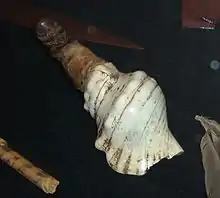%252C_the_classical_Meitei_musical_performing_art_of_blowing_Moibung_(conch_shell)_of_Kangleipak_(Manipur).jpg.webp)
.jpg.webp)
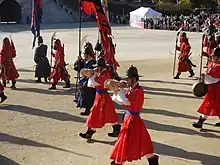
Conch, or conque, also known as a "seashell horn" or "shell trumpet", is a wind instrument that is made from a conch, the shell of several different kinds of sea snails. Their natural conical bore is used to produce a musical tone. Conch shell trumpets have been played in many Pacific Island countries, as well as South America and Southern Asia.[1]
The shells of large marine gastropods are blown into as if it were a trumpet, as in blowing horn. A completely unmodified conch may be used, or a mouth hole may be created. Wooden, bamboo, or metal mouthpieces may be inserted into the end of the shell.[2] Embouchure is used to produce notes from the harmonic series. A tone hole may be added to change the fundamental frequency but globally this is extremely rare.[3]
Various species of large marine gastropod shells can be turned into "blowing shells", but some of the more commonly used species include triton ('trumpet shell'), cassis ('helmet shell') and strombus ('true conch')."[2]
Prehistory
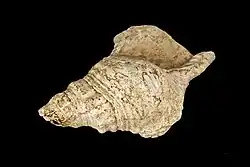
Shell trumpets have been known since the Magdalenian period (Upper Paleolithic), one example being the "conch Marsoulas", an archeological Charonia lampas shell trumpet which is on display at the Museum de Toulouse. In Israel/Palestine, the [Charonia tritonis nodifera] conch trumpet dates from approximately the third millennium BC.[3]
India, Nepal and Tibet

The sacred chank, Turbinella pyrum, is known in India as the shankha (first mentioned in the Artharvaveda, c. 1000 BCE[2]). In the Mahabharata, Lord Krishna blew the conch shell to announce the start and end of battles.[4] In Tibet it is known as dung-dkar or dungkar.[5]
Mesoamerica
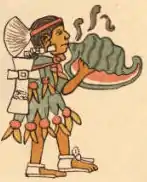
Throughout Mesoamerican history, conch trumpets were used, often in a ritual context (see figure). In Ancient Maya art, such conches were often decorated with ancestral images; scenes painted on vases show hunters and hunting deities blowing the conch trumpet. Quechua (Inca descendants) and Warao still use the conch.[7]
The Caribbean
The Queen Conch Strombus gigas was, and sometimes still is, used as a trumpet in the West Indies and other parts of the Caribbean. The Arawak word ‘fotuto’ was used to describe this instrument, and is still used to this day to refer to conch horns, and analogously, to bullhorns.
The Pacific Ocean area
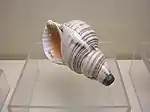
The Triton shell, also known as "Triton's trumpet" Charonia tritonis, is used as a trumpet in Melanesian and Polynesian culture, and also in Korea and Japan. In Japan this kind of trumpet is known as the horagai, which spread across Asia with Buddhism (first mentioned during the Heian period (794–1185 CE)[2]). Shingon Buddhist priests practice a ritual known as homa, which sometimes includes beating drums and blowing horagai.[8][9] In Korea it is known as the nagak. In some Polynesian islands it is known as "pu".[5]
Conch shell trumpets were historically used throughout Oceania,[2] in countries such as Fiji. The shells are still blown in Fijian resorts as a performance for tourists. The Fijians also used the conch shell when the chief died: the chief's body would be brought down a special path and the conch would be played until the chief's body reached the end of the path. In New Zealand, a type of conch with a wooden mouthpiece called the pūtātara is the main instrument used to herald guests in traditional welcoming ceremonies.[10][11]
Australia appears to be the only country in Oceania where conch shells were not used as a musical instrument, despite the widespread availability of shells.[12]
Africa
Austronesian settlers to the island of Madagascar brought along their conch shell which eventually became the antsiva (in the west coast) or bankora which was blown customarily as part of ceremonies such as circumcisions and funerals.[13] It was also incorporated into Merina royal regalia exclusively blown by male slaves to herald a royal's arrival, signalling mourning in time of death or even to mark battles.[13][14]
Europe
Wales
Cragen Beca is a conch shell trumpet. It was blown to call the legendary character Rebecca and her ‘Daughters’ to action during the infamous Rebecca Riots in Carmarthenshire of the mid-19th century (1839 – 43).[15]
Malta
In Malta the instrument is called a bronja, colloquially known as tronga. The shell of a sea snail is modified, with a hole at one end, and when blown it creates a loud noise. The tronja was generally used to inform the people that the windmills on the islands are operating that day due to being a windy day, which allows the grain of wheat and other grains to be ground.[16][17]
Modern use
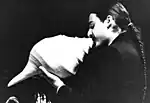
Carlos Chávez uses the trombone as a substitute for the conch in his 1940 piece Xochipilli.[18] American jazz trombonist Steve Turre also plays conches, in particular with his group Sanctified Shells.[19] The group released its first, eponymous album in 1993.[20][21][22][23]
An Indian conch, partially processed via an Echoplex delay, was featured prominently in the score for the film Alien (1979). Initially, composer Jerry Goldsmith used the conch during a scene depicting the extraterrestrial environment of a derelict spaceship. However, director Ridley Scott was so impressed by the eerie effect that he requested its use throughout the rest of the score, including during the main titles.[24]
Various conch shells performed by musician, Don Chilton are featured prominently throughout the soundtrack of the film Where the Crawdads Sing (2021) composed by Academy Award winning composer Mychael Danna.[25]
Media
References
- ↑ Hopkin, Bart (1996). Musical Instrument Design: Practical Information for Instrument Making Archived 2023-12-18 at the Wayback Machine, unpaginated. See Sharp. ISBN 9781884365836.
- 1 2 3 4 5 Herbert, Trevor and Wallace, John; eds. (1997). The Cambridge Companion to Brass Instruments, p.11-3. Cambridge University. ISBN 9780521565226.
- 1 2 Braun, Joachim (2002). Music in Ancient Israel/Palestine: Archaeological, Written, and Comparative Sources, p.181. Cites Hedley (1922) for this claim. Wm. B. Eerdmans. ISBN 9780802844774.
- ↑ Dutta, Madhumita (2008). Let's Know: Music and Musical Instruments of India, p.18. Star. ISBN 9781905863297.
- 1 2 Clark, Mitchell (1996). "Some Basics on Shell Trumpets". Perfect Sound Forever. Furious. Archived from the original on 2013-10-21. Retrieved 2009-08-13.
- ↑ Nahuatl dictionary. (1997). Wired humanities project. Retrieved August 31, 2012, from link Archived 2016-12-03 at the Wayback Machine
- ↑ Kuss, Malena (2010). Music in Latin America and the Caribbean, p.306. University of Texas. ISBN 9780292788404.
- ↑ Stephen Grover Covell (2005). Japanese Temple Buddhism: Worldliness in a Religion of Renunciation. University of Hawaii Press. pp. 2–4. ISBN 978-0-8248-2856-1.
- ↑ Paul Loren Swanson; Clark Chilson (2006). Nanzan Guide to Japanese Religions. University of Hawaii Press. pp. 240–242. ISBN 978-0-8248-3002-1.
- ↑ Harwood, Brenda (19 November 2020). "Call for community to gather for powhiri". The Star. Archived from the original on 15 November 2022. Retrieved 15 September 2023.
- ↑ "Taonga Puoro - Musical Instruments". Auckland War Memorial Museum. Archived from the original on 2023-01-23. Retrieved 2023-09-15.
- ↑ Hedley, C. (1922). "How Savages Use Sea Shells". The Australian Museum Magazine, Vol. I. pp. 163–67. Retrieved 2010-03-23 – via Web Archive.
- 1 2 The Museum of Art and Archeology of the University of Antananarivo. "Antsiva (marine conch)". Archived from the original on June 24, 2010. Retrieved November 26, 2010.
- ↑ Schmidhoffer, August (4–8 October 2005), "Some Remarks on the Austronesian Background of Malagasy Music" (PDF), The 2005 International Forum of Ethnomusicology in Taiwan, Taipei: Soochow University, Taiwan, archived (PDF) from the original on 17 July 2011, retrieved 4 December 2021
- ↑ "Amdanon // About". 2021-02-28. Archived from the original on 2023-08-05. Retrieved 2023-08-05.
- ↑ Lanfranco, G. (1983). "Tal-Mitħna tar-Riħ" (PDF). L-Imnara. Rivista tal-Għaqda Maltija tal-Folklor. 2 (2): 37. Archived from the original (PDF) on 18 April 2017.
- ↑ Testa, Frank. "L-Imtiehen". schoolnet.gov.mt. Archived from the original on 18 April 2017. Retrieved 29 June 2016.
- ↑ Conklin, Dorothy Rice. 1995. "Percussion Instruments in Two Compositions by Carlos Chávez: Xochipilli: An Imagined Aztec Music (1940) and Chapultepec: Three Famous Mexican Pieces (1935)", p.60–61. DMA diss. Greensboro: University of North Carolina at Greensboro.
- ↑ "Steve Turre's Sanctified Shells Band, from allaboutjazz.com, 2003-04-10". 10 April 2003. Archived from the original on 2009-01-11. Retrieved 2009-08-13.
- ↑ "Steve Turre Sounds the Trumpet: Ah, Make that Trombone and Conch," by Bob Blumenthal, Boston Globe January 19, 1993; ISSN 0743-1791
- ↑ All Music Guide to Jazz
2nd ed., Michael Erlewine (ed.); OCLC 35201244
4th ed., Vladimir Bogdanov, Christopher J. Woodstra (born 1969), Stephen Thomas Erlewine (eds.) (1996); OCLC 50477109 - ↑ The New Grove Dictionary of Jazz, Barry Dean Kernfeld, Stanley Sadie
1st ed. (1988); OCLC 16804283
3rd imprent of 1st ed. (1994); OCLC 30516743
2nd ed. (2002); OCLC 46956628 - ↑ Baker's Biographical Dictionary of Musicians (Turre is in Vol. 6 of 6), Macmillan; Schirmer
9th ed, Laura Diane Kuhn (ed.) (born 1953) (2001); OCLC 44972043 - ↑ Mike Matessino, CD-booklet Alien: Complete Original Motion Picture Soundtrack, Intrada (MAF 7102), 2007
- ↑ Korpan, Andrew (2022-09-01). "Oscar-Winning Composer Mychael Danna Talks Creating a Sound Reminiscent of the North Carolina Marshes". Coastal House Media. Archived from the original on 2023-09-22. Retrieved 2023-08-04.
